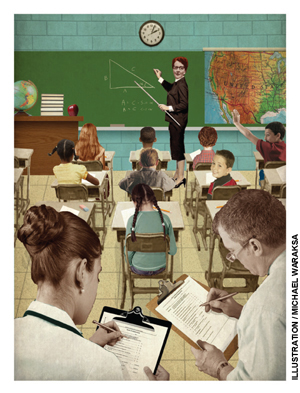Classroom Observation is a formal or informal observation of teaching while it is taking place in a classroom or other learning environment.
Other terms for Classroom Observation: learning walks, teacher observations, walkthroughs
- Typically done by fellow teachers, administrators, or instructional specialists
- Often used to provide teachers with constructive critical feedback aimed at improving their classroom management and instructional techniques.
- School administrators also regularly observe teachers as an extension of formal job-performance evaluations.
- May be conducted for shorter or longer periods of time—from a few minutes to a full class period or school day.
Methods:
- nationally utilized models developed by educational experts,
- homegrown processes created by the educators using them.
Observation notes:
- Recorded using common templates or guidelines that describe what observers should be looking for or what the observed teacher would like feedback on.
- Digital and online technologies—such as smartphones, tablets, and subscription-based online systems—that can provide educators with observational functionality and data analytics that would not be possible if paper-based processes were used.
Purposes:
- Job-performance evaluations conducted by school administrators and with professional learning communities—groups of teachers who work together to improve their instructional skills. Classroom observations may be conducted by teachers in the same content areaor grade level—in these cases, teachers share students or similar expertise
- To observe and learn from the varied instructional practices used in different types of classes: done by teachers across academic disciplines
It should also be noted that many educators make a strict delineation between observations made for the purposes of helping a teacher improve, and those conducted for the purposes of job-performance evaluation. Some educators may object to the use of walkthrough, or other terms associated with non-administrative observations, when referencing evaluative observations by school administrators.
Issues:
If classroom observations are used as part of a job-evaluation process, school leaders, teachers, and teacher unions may have divergent ideas about how the observations should be conducted and what the evaluation criteria should be. In addition, while classroom observations have long been used in the job-performance evaluations of teachers, some critics contend that the observations contribute relatively little to the improvement of teaching for several possible reasons:
- Principals may not use consistent, evidence-basedevaluation criteria.
- Principals may not have been trained in proper observation strategies, or they may not have the teaching experience or expertise required to evaluate instructional techniques.
- Job-performance observations are typically prescheduled, which means that teachers can prepare in advance and alter their methods, and that the quality of teaching on the observed day may not be representative of a teacher’s normal practice.
- The feedback teachers receive may be superficial, inconsistent, or unhelpful in terms of improving instructional quality.
- Most teachers receive high job-performance ratings from principals, even in poorly performing schools where there is evidence that low-quality teaching is occurring.
Classroom observations may also challenge established institutional conventions and teaching practices, which can make the strategy an emotional topic in some schools. For example, some teachers may not see any value in the process, they take issue with the specific criteria being used, they may not approve of certain people watching them teach, or they may be uncomfortable with the idea of being observed because they may feel threatened or insecure in such situations.
